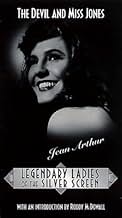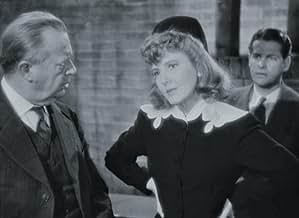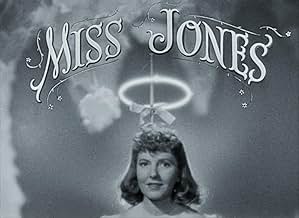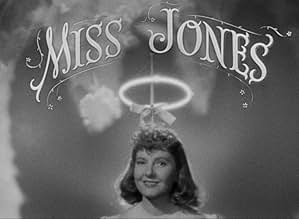VALUTAZIONE IMDb
7,6/10
5020
LA TUA VALUTAZIONE
Aggiungi una trama nella tua linguaA tycoon goes undercover to ferret out agitators at a department store, but gets involved in their lives instead.A tycoon goes undercover to ferret out agitators at a department store, but gets involved in their lives instead.A tycoon goes undercover to ferret out agitators at a department store, but gets involved in their lives instead.
- Regia
- Sceneggiatura
- Star
- Candidato a 2 Oscar
- 3 vittorie e 2 candidature totali
S.Z. Sakall
- George
- (as S.Z. Sakall)
Recensioni in evidenza
This is a wonderful story from the days immediately preceding America's entry into WWII, when the values that made America great were on display in the movies. A powerful department store owner, played by Charles Coburn, gets a job as a lowly clerk in his own store, in order to ferret out the workers who are trying to organize a labor union. He gradually gets caught up in the lives of the clerks in the shoe department (co-stars Jean Arthur, Bob Cummings, Spring Byington, Edmund Gwen) who accept him as just a poor, older man, and his view of things begins to shift. There are some excellent scenes in this movie, especially one in which Coburn is arrested while on a day at the beach with his fellow workers, and has to be kept out of jail by Cummings' bravado. Of course, everything works out well in the end, because this movie was made in the days when good was destined to triumph over evil.
Ever since I saw Jean Arthur in "The More The Merrier", I fell in love with her. What beauty, what talent, what a VOICE!
This is one of her better films. More reminiscent of a Capra film. It's the working class vs the wealthy uncaring class. This goes beyond that though. It tells the tale of a rich man(Coburn) who hears of a revolt at one of his businesses. He wants it stopped and he wants heads to roll!!
When he thinks the investigation is not going to his liking, he decides to go undercover himself. Now this is where the REAL story starts. Now he is on THEIR ground and he sees for himself what these working class "pigs" are really like. They are just people. People with little money and big hearts, who just want a better life.
Everyone is wonderful in this film. Jean Arthur and Charles Coburn work terrific together as always(no wonder they did three movies together). I was surprised to see Robert Cummings in a major role back in 1941. I didn't know he was a star before Television.
The only real disappointment I had with this film was Edmund Gwenn. I could not believe it. The man that IS Santa Claus played a mean rude little man. EGAD!!
Seriously though, This is a MUST SEE for those who love good hearted comedies. Just makes you feel so good. An 8 out of 10.
This is one of her better films. More reminiscent of a Capra film. It's the working class vs the wealthy uncaring class. This goes beyond that though. It tells the tale of a rich man(Coburn) who hears of a revolt at one of his businesses. He wants it stopped and he wants heads to roll!!
When he thinks the investigation is not going to his liking, he decides to go undercover himself. Now this is where the REAL story starts. Now he is on THEIR ground and he sees for himself what these working class "pigs" are really like. They are just people. People with little money and big hearts, who just want a better life.
Everyone is wonderful in this film. Jean Arthur and Charles Coburn work terrific together as always(no wonder they did three movies together). I was surprised to see Robert Cummings in a major role back in 1941. I didn't know he was a star before Television.
The only real disappointment I had with this film was Edmund Gwenn. I could not believe it. The man that IS Santa Claus played a mean rude little man. EGAD!!
Seriously though, This is a MUST SEE for those who love good hearted comedies. Just makes you feel so good. An 8 out of 10.
10jotix100
Norman Krasna, was one of the best screen writers in the movies of the period. Sam Wood shows his ability to direct this excellent cast in one of the most satisfying comedies about the distinctions between the moneyed classes and the working stiffs they employed.
If you haven't seen the film, please stop reading now.
J.P. Merrick, is a millionaire who has investments all over New York. It is to his amazement he sees himself burned in effigy in front of the department store he has forgotten he owns. Merrick, like all people in business don't want to appear to be exploiting the workers, but this is too much! He must put an end to it.
In disguising himself as a salesman, he goes directly where the problem seems to be coming from, the shoe department. There he meets Mary Jones, who immediately feels Tom Higgins, his assumed name, is a man that is going through a rough time in his life. Mary feels pity when she realizes he doesn't know a thing about salesmanship.
In spite of everything going bad for him as a shoe salesman, Tom sticks to his new persona. He only meets kindness from all the people he is trying to fire. Merrick, by the end of the first full day at the store feels the strain of being on his feet all the time; we watch him soaking his feet in hot water, aided by his butler, George. In the process of gaining knowledge about the trouble makers, Merrick becomes human. He gets to realize how wrong he has been about a life he has lived so alienated from.
"The Devil and Miss Jones" is a movie that will delight anyone wishing to have fun. Of course, this is a film that depends totally in the two principals, Jean Arthur, who plays Mary Jones, and Charles Coburn, who as J.P Merrick/Tom Higgins shows why they were about the best actors working in the cinema in the 30s and 40s in Hollywood. Not only did they bring such class to whatever they played, but they are totally convincing. Ms. Arthur was a natural and so was Mr. Coburn.
The rest of the cast is extraordinary. A young Robert Cummings is perfect in his role as the union man. Spring Byinton, an actress that appeared in many films, is a charming Elizabeth, the woman that steals Merrick/Higgins heart. In her first scene with Mr. Coburn, she sits in the park bench to have lunch and he has nothing to eat. She gives him one of her tuna popovers and clarifies for him she paid 12 cents for the can! What times! In minor roles, S. Z. Sakall is George, the loyal butler. Mr. Sakall is a joy to watch, no matter what picture, or what character he is playing. Also, Edmund Gwenn, who probably stayed behind to played Santa Claus for the store, makes an incredible Hooper, the man in charge of the shoe department.
Thanks to Sam Wood's inspired direction this is a film that will not cease to please.
If you haven't seen the film, please stop reading now.
J.P. Merrick, is a millionaire who has investments all over New York. It is to his amazement he sees himself burned in effigy in front of the department store he has forgotten he owns. Merrick, like all people in business don't want to appear to be exploiting the workers, but this is too much! He must put an end to it.
In disguising himself as a salesman, he goes directly where the problem seems to be coming from, the shoe department. There he meets Mary Jones, who immediately feels Tom Higgins, his assumed name, is a man that is going through a rough time in his life. Mary feels pity when she realizes he doesn't know a thing about salesmanship.
In spite of everything going bad for him as a shoe salesman, Tom sticks to his new persona. He only meets kindness from all the people he is trying to fire. Merrick, by the end of the first full day at the store feels the strain of being on his feet all the time; we watch him soaking his feet in hot water, aided by his butler, George. In the process of gaining knowledge about the trouble makers, Merrick becomes human. He gets to realize how wrong he has been about a life he has lived so alienated from.
"The Devil and Miss Jones" is a movie that will delight anyone wishing to have fun. Of course, this is a film that depends totally in the two principals, Jean Arthur, who plays Mary Jones, and Charles Coburn, who as J.P Merrick/Tom Higgins shows why they were about the best actors working in the cinema in the 30s and 40s in Hollywood. Not only did they bring such class to whatever they played, but they are totally convincing. Ms. Arthur was a natural and so was Mr. Coburn.
The rest of the cast is extraordinary. A young Robert Cummings is perfect in his role as the union man. Spring Byinton, an actress that appeared in many films, is a charming Elizabeth, the woman that steals Merrick/Higgins heart. In her first scene with Mr. Coburn, she sits in the park bench to have lunch and he has nothing to eat. She gives him one of her tuna popovers and clarifies for him she paid 12 cents for the can! What times! In minor roles, S. Z. Sakall is George, the loyal butler. Mr. Sakall is a joy to watch, no matter what picture, or what character he is playing. Also, Edmund Gwenn, who probably stayed behind to played Santa Claus for the store, makes an incredible Hooper, the man in charge of the shoe department.
Thanks to Sam Wood's inspired direction this is a film that will not cease to please.
The Devil And Miss Jones was the first film of which there were to be many in which Frank Ross produced and his wife Jean Arthur starred for RKO. The team did do one other, A Lady Takes A Chance, and Ross did some writing for The More The Merrier, but the Ross/Arthur marriage was breaking up and no more films followed.
That's a pity because The Devil And Miss Jones is a sparkling comedy about a very rich man who goes incognito among his employees to see how they live.
Of course that's not what Charles Coburn's original intent. Coburn has a passion for anonymity the same way Donald Trump loves seeing his name in the papers. When this reclusive millionaire gets picketed at his home by workers from a department store that's one of his minor holdings, Coburn isn't happy. He decides to find out just who the leftwing subversives are and takes a job as a shoe salesman in said department store.
What he does find that is that the place is run by a gang of petty tyrants, using and abusing the authority of his name. He also gets to know the union heads who in this case are a young couple, Jean Arthur and Robert Cummings.
But what really made The Devil And Miss Jones sparkle was the October romance of Coburn and Arthur's friend Spring Byington. They just might qualify as the oldest romantic coupling in film history. But they were a delightful pair. I'll bet when Coburn was young the women threw themselves at him like crazy. But as he got older and cynical it wasn't what he wanted, a trophy wife was not on the list. Some real love was just what Coburn needed.
The Devil And Miss Jones got two Oscar nominations, for Best Original Screenplay for Norman Krasna and for Best Supporting Actor for Charles Coburn. He lost the race to Donald Crisp for How Green Was My Valley which really was a supporting role. Coburn in fact is in the lead, he has more screen time than either Arthur or Cummings.
Jean Arthur was a wise woman, she could have pulled star rank with the producer and gotten more time, but she knew that Coburn was the one who made the film.
This was a timely film then and still topical now. Organized labor was gaining the right to collective bargaining under the Wagner Act in those years and the papers were full of places like this department store finally gaining a union shop. It's something that labor still fights for though on different fronts today.
As a political film, The Devil And Miss Jones is very much relevant today. As a comedy it's still very funny as Charles Coburn learns that real love is something all his money can't buy.
That's a pity because The Devil And Miss Jones is a sparkling comedy about a very rich man who goes incognito among his employees to see how they live.
Of course that's not what Charles Coburn's original intent. Coburn has a passion for anonymity the same way Donald Trump loves seeing his name in the papers. When this reclusive millionaire gets picketed at his home by workers from a department store that's one of his minor holdings, Coburn isn't happy. He decides to find out just who the leftwing subversives are and takes a job as a shoe salesman in said department store.
What he does find that is that the place is run by a gang of petty tyrants, using and abusing the authority of his name. He also gets to know the union heads who in this case are a young couple, Jean Arthur and Robert Cummings.
But what really made The Devil And Miss Jones sparkle was the October romance of Coburn and Arthur's friend Spring Byington. They just might qualify as the oldest romantic coupling in film history. But they were a delightful pair. I'll bet when Coburn was young the women threw themselves at him like crazy. But as he got older and cynical it wasn't what he wanted, a trophy wife was not on the list. Some real love was just what Coburn needed.
The Devil And Miss Jones got two Oscar nominations, for Best Original Screenplay for Norman Krasna and for Best Supporting Actor for Charles Coburn. He lost the race to Donald Crisp for How Green Was My Valley which really was a supporting role. Coburn in fact is in the lead, he has more screen time than either Arthur or Cummings.
Jean Arthur was a wise woman, she could have pulled star rank with the producer and gotten more time, but she knew that Coburn was the one who made the film.
This was a timely film then and still topical now. Organized labor was gaining the right to collective bargaining under the Wagner Act in those years and the papers were full of places like this department store finally gaining a union shop. It's something that labor still fights for though on different fronts today.
As a political film, The Devil And Miss Jones is very much relevant today. As a comedy it's still very funny as Charles Coburn learns that real love is something all his money can't buy.
This film is under the radar for one reason only: character actors Charles Coburn and Spring Byington step from behind the shadow of the leads and take a bite out of the script themselves, and man, what a bite. Not to say that Jean Arthur and Robert Cummings don't do their part, because they do, but the emphasis here is on the old folks for a change, and its a refreshing change. There's also a scene on Coney Island, back when it was the shizzle, and its a wonderful scene for warmly placing you there in the midst of a steaming humanity all trying to cool off. There's a Caprasque story impetus about the problems of the rich versus the poor, along with some liberal solutions to those problems, but what's really nice is about watching folks who are past redemption finding it at the most unexpected time of life. Hope for everyone here. Too bad its only a movie.
Lo sapevi?
- QuizJean Arthur planned to remake the picture with her as the devil titled "The Devil and Mr. Jones", but that project never materialized.
- BlooperDuring the beach scene, the people in the background change completely from shot to shot. However, the crowd in the opening shot of the beach scene is the same as the one in the final shot.
- Citazioni
First Policeman: When they start recitin' the Constitution, watch out!
- Curiosità sui creditiThe foreword after the opening credits reads: Dear Richest Men in the World: We made up this character in the story, out of our own heads. It's nobody, really. The whole thing is make-believe. We'd feel awful if anyone was offended. Thank you, The Author, Director and Producer. P.S. Nobody sue. P.P.S. Please.
- ConnessioniFeatured in Ebert Presents: At the Movies: Episodio #1.12 (2011)
- Colonne sonoreThe Blue Danube Waltz, Opus 314
(1867) (uncredited)
Written by Johann Strauss
Played aboard ship at the end and danced by Merrick and the employees.
I più visti
Accedi per valutare e creare un elenco di titoli salvati per ottenere consigli personalizzati
- How long is The Devil and Miss Jones?Powered by Alexa
Dettagli
- Data di uscita
- Paese di origine
- Lingua
- Celebre anche come
- The Devil and Miss Jones
- Luoghi delle riprese
- Azienda produttrice
- Vedi altri crediti dell’azienda su IMDbPro
- Tempo di esecuzione1 ora 32 minuti
- Colore
- Proporzioni
- 1.37 : 1
Contribuisci a questa pagina
Suggerisci una modifica o aggiungi i contenuti mancanti

Divario superiore
By what name was Il diavolo si converte (1941) officially released in India in English?
Rispondi



































